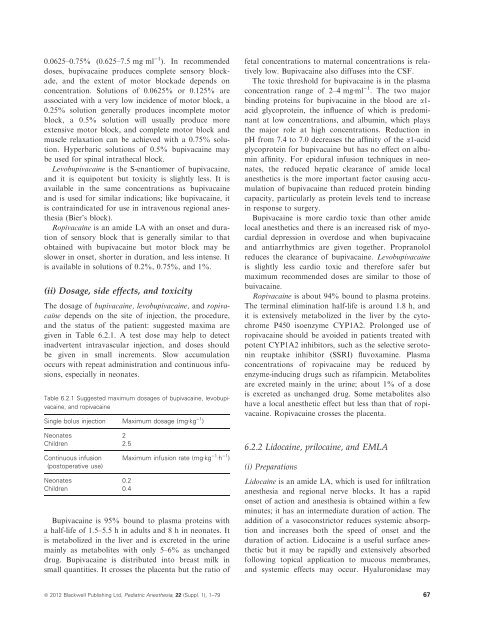Good Practice in Postoperative and Procedural Pain Management ...
Good Practice in Postoperative and Procedural Pain Management ...
Good Practice in Postoperative and Procedural Pain Management ...
Create successful ePaper yourself
Turn your PDF publications into a flip-book with our unique Google optimized e-Paper software.
0.0625–0.75% (0.625–7.5 mg ml )1 ). In recommendeddoses, bupivaca<strong>in</strong>e produces complete sensory blockade,<strong>and</strong> the extent of motor blockade depends onconcentration. Solutions of 0.0625% or 0.125% areassociated with a very low <strong>in</strong>cidence of motor block, a0.25% solution generally produces <strong>in</strong>complete motorblock, a 0.5% solution will usually produce moreextensive motor block, <strong>and</strong> complete motor block <strong>and</strong>muscle relaxation can be achieved with a 0.75% solution.Hyperbaric solutions of 0.5% bupivaca<strong>in</strong>e maybe used for sp<strong>in</strong>al <strong>in</strong>trathecal block.Levobupivaca<strong>in</strong>e is the S-enantiomer of bupivaca<strong>in</strong>e,<strong>and</strong> it is equipotent but toxicity is slightly less. It isavailable <strong>in</strong> the same concentrations as bupivaca<strong>in</strong>e<strong>and</strong> is used for similar <strong>in</strong>dications; like bupivaca<strong>in</strong>e, itis contra<strong>in</strong>dicated for use <strong>in</strong> <strong>in</strong>travenous regional anesthesia(Bier’s block).Ropivaca<strong>in</strong>e is an amide LA with an onset <strong>and</strong> durationof sensory block that is generally similar to thatobta<strong>in</strong>ed with bupivaca<strong>in</strong>e but motor block may beslower <strong>in</strong> onset, shorter <strong>in</strong> duration, <strong>and</strong> less <strong>in</strong>tense. Itis available <strong>in</strong> solutions of 0.2%, 0.75%, <strong>and</strong> 1%.(ii) Dosage, side effects, <strong>and</strong> toxicityThe dosage of bupivaca<strong>in</strong>e, levobupivaca<strong>in</strong>e, <strong>and</strong> ropivaca<strong>in</strong>edepends on the site of <strong>in</strong>jection, the procedure,<strong>and</strong> the status of the patient: suggested maxima aregiven <strong>in</strong> Table 6.2.1. A test dose may help to detect<strong>in</strong>advertent <strong>in</strong>travascular <strong>in</strong>jection, <strong>and</strong> doses shouldbe given <strong>in</strong> small <strong>in</strong>crements. Slow accumulationoccurs with repeat adm<strong>in</strong>istration <strong>and</strong> cont<strong>in</strong>uous <strong>in</strong>fusions,especially <strong>in</strong> neonates.Table 6.2.1 Suggested maximum dosages of bupivaca<strong>in</strong>e, levobupivaca<strong>in</strong>e,<strong>and</strong> ropivaca<strong>in</strong>eS<strong>in</strong>gle bolus <strong>in</strong>jection Maximum dosage (mgÆkg )1 )Neonates 2Children 2.5Cont<strong>in</strong>uous <strong>in</strong>fusion(postoperative use)Neonates 0.2Children 0.4Maximum <strong>in</strong>fusion rate (mgÆkg )1 Æh )1 )Bupivaca<strong>in</strong>e is 95% bound to plasma prote<strong>in</strong>s witha half-life of 1.5–5.5 h <strong>in</strong> adults <strong>and</strong> 8 h <strong>in</strong> neonates. Itis metabolized <strong>in</strong> the liver <strong>and</strong> is excreted <strong>in</strong> the ur<strong>in</strong>ema<strong>in</strong>ly as metabolites with only 5–6% as unchangeddrug. Bupivaca<strong>in</strong>e is distributed <strong>in</strong>to breast milk <strong>in</strong>small quantities. It crosses the placenta but the ratio offetal concentrations to maternal concentrations is relativelylow. Bupivaca<strong>in</strong>e also diffuses <strong>in</strong>to the CSF.The toxic threshold for bupivaca<strong>in</strong>e is <strong>in</strong> the plasmaconcentration range of 2–4 mgÆml )1 . The two majorb<strong>in</strong>d<strong>in</strong>g prote<strong>in</strong>s for bupivaca<strong>in</strong>e <strong>in</strong> the blood are a1-acid glycoprote<strong>in</strong>, the <strong>in</strong>fluence of which is predom<strong>in</strong>antat low concentrations, <strong>and</strong> album<strong>in</strong>, which playsthe major role at high concentrations. Reduction <strong>in</strong>pH from 7.4 to 7.0 decreases the aff<strong>in</strong>ity of the a1-acidglycoprote<strong>in</strong> for bupivaca<strong>in</strong>e but has no effect on album<strong>in</strong>aff<strong>in</strong>ity. For epidural <strong>in</strong>fusion techniques <strong>in</strong> neonates,the reduced hepatic clearance of amide localanesthetics is the more important factor caus<strong>in</strong>g accumulationof bupivaca<strong>in</strong>e than reduced prote<strong>in</strong> b<strong>in</strong>d<strong>in</strong>gcapacity, particularly as prote<strong>in</strong> levels tend to <strong>in</strong>crease<strong>in</strong> response to surgery.Bupivaca<strong>in</strong>e is more cardio toxic than other amidelocal anesthetics <strong>and</strong> there is an <strong>in</strong>creased risk of myocardialdepression <strong>in</strong> overdose <strong>and</strong> when bupivaca<strong>in</strong>e<strong>and</strong> antiarrhythmics are given together. Propranololreduces the clearance of bupivaca<strong>in</strong>e. Levobupivaca<strong>in</strong>eis slightly less cardio toxic <strong>and</strong> therefore safer butmaximum recommended doses are similar to those ofbuivaca<strong>in</strong>e.Ropivaca<strong>in</strong>e is about 94% bound to plasma prote<strong>in</strong>s.The term<strong>in</strong>al elim<strong>in</strong>ation half-life is around 1.8 h, <strong>and</strong>it is extensively metabolized <strong>in</strong> the liver by the cytochromeP450 isoenzyme CYP1A2. Prolonged use ofropivaca<strong>in</strong>e should be avoided <strong>in</strong> patients treated withpotent CYP1A2 <strong>in</strong>hibitors, such as the selective seroton<strong>in</strong>reuptake <strong>in</strong>hibitor (SSRI) fluvoxam<strong>in</strong>e. Plasmaconcentrations of ropivaca<strong>in</strong>e may be reduced byenzyme-<strong>in</strong>duc<strong>in</strong>g drugs such as rifampic<strong>in</strong>. Metabolitesare excreted ma<strong>in</strong>ly <strong>in</strong> the ur<strong>in</strong>e; about 1% of a doseis excreted as unchanged drug. Some metabolites alsohave a local anesthetic effect but less than that of ropivaca<strong>in</strong>e.Ropivaca<strong>in</strong>e crosses the placenta.6.2.2 Lidoca<strong>in</strong>e, priloca<strong>in</strong>e, <strong>and</strong> EMLA(i) PreparationsLidoca<strong>in</strong>e is an amide LA, which is used for <strong>in</strong>filtrationanesthesia <strong>and</strong> regional nerve blocks. It has a rapidonset of action <strong>and</strong> anesthesia is obta<strong>in</strong>ed with<strong>in</strong> a fewm<strong>in</strong>utes; it has an <strong>in</strong>termediate duration of action. Theaddition of a vasoconstrictor reduces systemic absorption<strong>and</strong> <strong>in</strong>creases both the speed of onset <strong>and</strong> theduration of action. Lidoca<strong>in</strong>e is a useful surface anestheticbut it may be rapidly <strong>and</strong> extensively absorbedfollow<strong>in</strong>g topical application to mucous membranes,<strong>and</strong> systemic effects may occur. Hyaluronidase mayª 2012 Blackwell Publish<strong>in</strong>g Ltd, Pediatric Anesthesia, 22 (Suppl. 1), 1–79 67
















